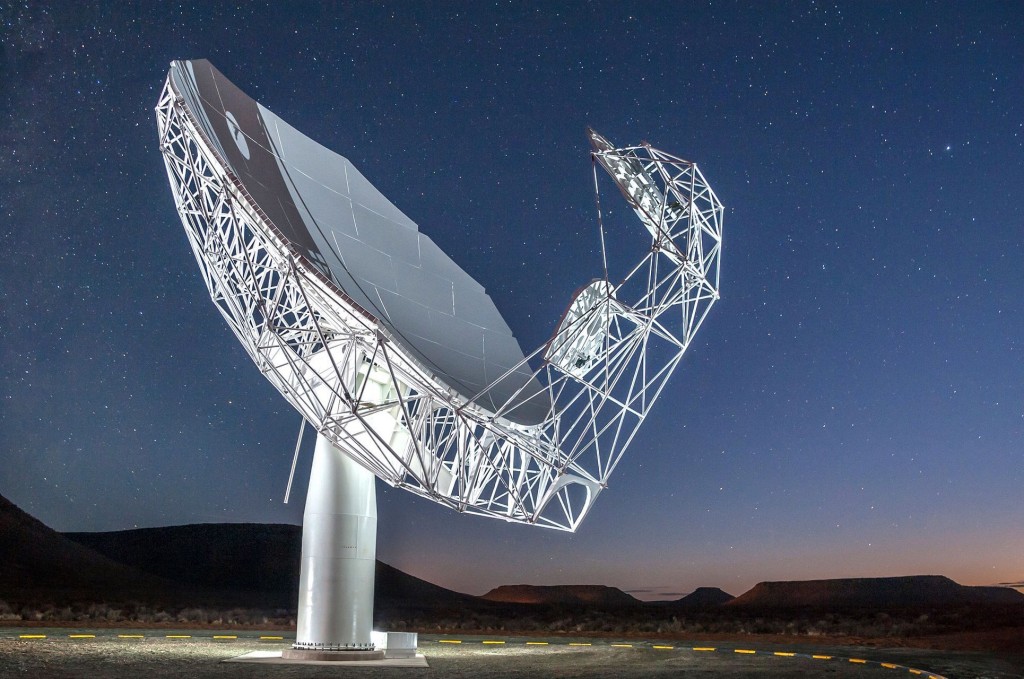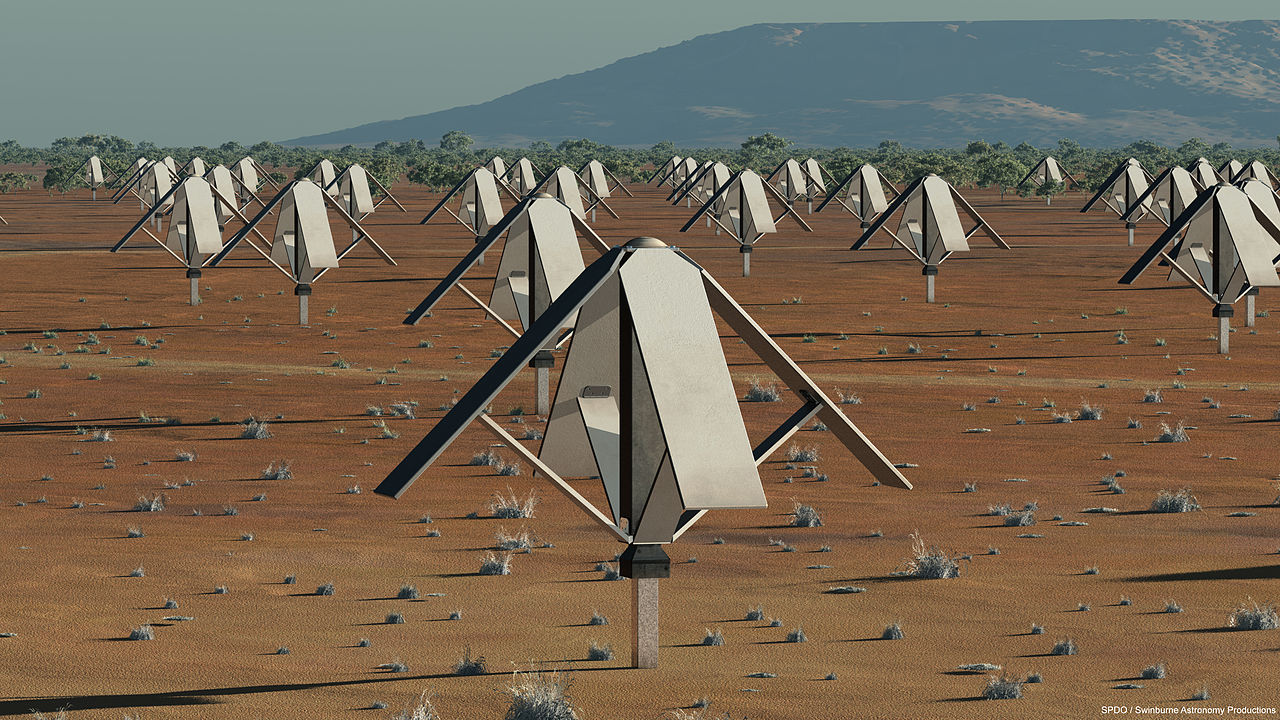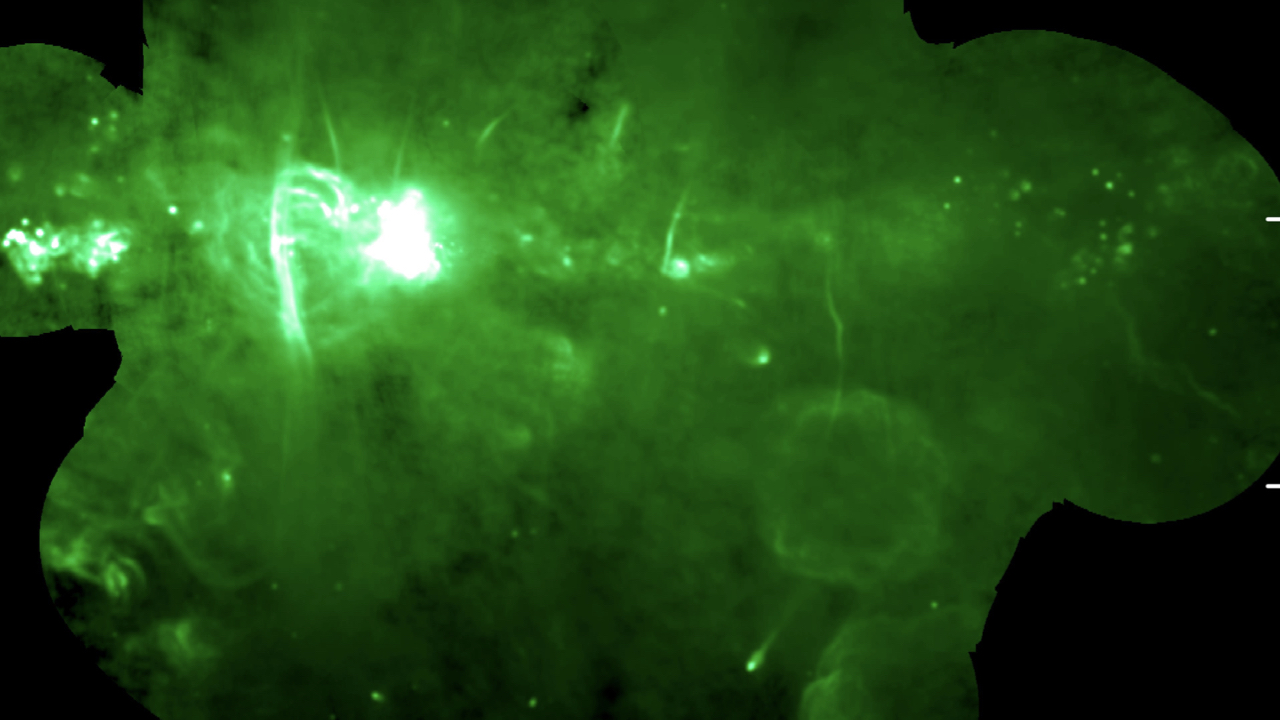Our Galaxy’s Heart: No Longer Bubbling Deadly Radiation
Physicians possess various tools for determining the health status of your heart. In addition to stethoscopes, physicians possess advanced instruments like electrocardiograms, echocardiograms, and angiograms to determine the health of human hearts. Likewise, astronomers now possess advanced telescope and imaging instruments to determine the health of our Milky Way Galaxy’s heart. These instruments reveal an unusual “health” that speaks of galaxy design.
MeerKAT and the Square Kilometer Array
The latest and most advanced of these tools is the MeerKAT telescope in South Africa (see figure 1). MeerKAT is the first phase of the Square Kilometer Array (SKA).

Figure 1: One of 64 Radio Telescopes Comprising the MeerKAT Array. Each telescope has a collecting area of 15 meters in height and 12 meters in width (49 feet by 40 feet). Image credit: Morganoshell, Creative Commons Attribution
The array will consist of thousands of parabolic dishes like the one in figure 1 plus thousands of dipole antennae (see figure 2). Both the array of parabolic dishes and the dipole antenna array will have a collecting area of one square kilometer. About half of the parabolic dishes and dipole antennae will be located in South Africa and the other half in Australia.

Figure 2: Part of the Dipole Antennae Component of the Square Kilometer Array. Image credit: SKA Project Development Office and Swinburne Astronomy Productions
The enormous collecting area of the SKA will make it fifty times more sensitive than any other radio telescope. The SKA will be built to simultaneously and continuously collect radio light over a very broad frequency range: 50 Hertz to 14 Gigahertz. The amount of data the SKA can collect is greater than the entire global internet traffic as of 2014. The data will be processed by an equally impressive array of supercomputers. Eleven nations are committed to fund and build the SKA: Australia, Canada, China, India, Italy, the Netherlands, New Zealand, South Africa, Spain, Sweden, and United Kingdom.
Probing the Heart of the Milky Way Galaxy
I explain some technical details in the next section. Feel free to skim as you make your way to Philosophical Implications.
MeerKAT’s first major achievement was the production of the most-detailed radio wavelength map of the region of the center of the Milky Way Galaxy (MWG). MeerKAT astronomers mapped this region with a resolution of 6 arcseconds (1/600th of a degree), more than ten times more precise than any previous attempt.
MeerKAT’s first major discovery was finding two radio bubbles above and below the central core of our galaxy.1 Astronomers have found gigantic radio bubbles in other galaxies but these bubbles are much smaller. They are, however, by far the largest that astronomers have discovered in our galaxy. Together they stretch out over 430 parsecs (1,400 light-years). Their width is 140 parsecs (460 light-years). For comparison the Sun is 25,900 light-years away from the galactic center.2
From observations of similar radio bubbles in the cores of other large galaxies, astronomers know that such bubbles are the remnants of energetic eruptions of hot gas. The 99 astronomers who published the MeerKAT discovery, led by Ian Heywood, Fernando Camilo, and L. P. Williams, offered two possible explanations for the bubbles.
One explanation is that the 4-million-solar-mass black hole at the galactic center3 injested a large amount of matter in the relatively recent past. When supermassive black holes gobble up matter in this way, they trigger outbursts just outside the black hole’s event horizon that result in large radio bubbles.
The second explanation involves a “starburst” event near the galactic center. A starburst occurs when a hundred or more large and giant stars form all at once within a small region. These stars burn through their nuclear fuel quickly, culminating in supernova eruptions. The near simultaneous supernova eruptions send out enormous, powerful shock waves that blow a big hole in the thick interstellar medium existing in the galactic core.
As the 99 authors point out, a combination of outbursts from outside the supermassive black hole’s event horizon and a starburst event likely would have reinforced the building of the radio bubbles. The team determined that the total energy involved in the bubbles equals 7 x 1052 ergs, which is equivalent to the amount of energy emitted by 580 million Suns in one year.
The measured radio spectrum of the bubbles revealed that its energy source is synchrotron radiation (nonthermal radiation generated by fast-moving electrons traveling through magnetic fields), which allowed the astronomers to determine the bubbles’ cooling time. Assuming no substantial deceleration in the bubbles’ growth (a reasonable assumption given the energy in the bubbles), the researchers calculated that the two bubbles are approximately 7 million years old. This age proves interesting to astronomers because a known starburst event occurred just 0.5 parsecs (1.6 light-years) from the MWG’s supermassive black hole about 6 million years ago.4
Another extraordinary feature about the two bubbles is that they apparently explain the origin of a network of more than 100 magnetized radio filaments in the galactic center region5 that have mystified astronomers since they were first discovered 35 years ago (see figure 3).6 These filaments exist nowhere else in the MWG. Like the two radio bubbles, these filaments are polarized and possess a synchrotron radiation spectrum. They are spatially associated with the two radio bubbles.

Figure 3: Some of the Radio Filaments in the Galactic Center Region. The bright region (left center) is the location of the supermassive black hole. The linear radio filaments are above and to the right of this area. This map was produced by a combination of Very Large Array and Greenbank Telescope data. image credit: NRAO/AUI/NSF, Yusef-Zadeh et al.
The team of 99 showed that when their map is viewed in projection, the two “bubble cavities contain an enhanced number of bright and multiple-filament complexes.”7 Hence, they concluded “the event that generated the bubbles was also the source of the relativistic particles required to illuminate the filaments on a large scale.”8 They further concluded that the two radio-wavelength bubbles they discovered were “a less energetic version of a process similar to that which created the Fermi bubbles”9 (which two different teams of astronomers discovered at gamma-ray-wavelengths in 2013).10
Philosophical Implications
The large team of researchers did not draw any philosophical implications from their discovery other than to comment that the two radio bubbles they discovered are an “example of a series of such intermittent events” that explain “the observed radio, X-ray and γ-ray structures”11 in the region of the galactic center. However, as an astronomer I think their measurements and those by the teams that discovered the Fermi bubbles establish that when these events occur, they are, at best, detrimental to human health and catastrophic to human civilization and, at worst, deadly to all humans.
As I have described in several previous blogs,12 we live in an exceptionally quiet, undisturbed galaxy. The MWG is the only known large galaxy with no merger events with large-dwarf or medium-sized galaxies over the past 10 billion years and with a small enough supermassive black hole to make advanced life possible somewhere in the galaxy.
In spite of the exceptionally small size of our galaxy’s supermassive black hole, events detrimental or deadly to humans and human civilization frequently occur, as this discovery and other measurements show. The good news is that humans happen to be living in between such events, highlighting the fact that at the present time our galaxy’s heart is conspicuously healthy. Such fortuitous events rank as more evidence that can be added to the abundance that already exists13 that the timing of our entry to Earth’s surface was no accident. It must have been planned and orchestrated.
Featured image: Galactic Center Region of the Milky Way Galaxy in the Infrared
Image credit: NASA/JPL-Caltech/Spitzer Science Center
Check out more from Reasons to Believe @Reasons.org
Endnotes
- I. Heywood, F. Camilo, and L. P. Williams, “Inflation of 430-Parsec Bipolar Radio Bubbles in the Galactic Centre by an Energetic Event,” Nature 573 (September 11, 2019): 235–37, doi:10.1038/s41586-019-1532-5.
- Tuan Do et al., “Relativistic Redshift of the Star S0-2 Orbiting the Galactic Center Supermassive Black Hole,” Science 365, no. 6454 (August 16, 2019): 667, doi:10.1126/science.aav8137.
- Do et al., “Relativistic Redshift,” 667.
- Mark Wardle and Farhad Yusef-Zadeh, “On the Origin of the Central 1” Hole in the Stellar Disk of Sgr A* and the Fermi Gamma-Ray Bubbles,” Astrophysical Journal Letters 787, no. 1 (May 20, 2014): id. L14, doi:10.1088/2041-8205/787/1/L14.
- F. Yusef-Zadeh, J. W. Hewitt, and W. Cotton, “A 20 Centimeter Survey of the Galactic Center Region. I. Detection of Numerous Linear Filaments,” Astrophysical Journal Supplement Series 155, no. 2 (December 2004): 421–550, doi:10.1086/425257.
- Farhad Yusef-Zadeh, Mark Morris, and D. Chance, “Large, Highly Organized Radio Structures Near the Galactic Centre,” Nature 310 (August 16, 1984): 557–61, doi:10.1038/310557a0.
- Heywood et al., “Inflation of 430-Parsec Bipolar Radio Bubbles,” 237.
- Heywood et al., “Inflation of 430-Parsec Bipolar Radio Bubbles,” 237.
- Heywood et al., “Inflation of 430-Parsec Bipolar Radio Bubbles,” 237.
- Meng Su, Tracy R. Slatyer, and Douglas P. Finkbeiner, “Giant Gamma-Ray Bubbles from Fermi-LAT: Active Galactic Nucleus Activity or Bipolar Galactic Wind?,” Astrophysical Journal 724, no. 2 (December 1, 2010): 1044–82, doi:10.1088/0004-637X/724/2/1044; Ettore Carretti et al., “Giant Magnetized Outflows from the Centre of the Milky Way,” Nature 493 (January 3, 2013): 66–69, doi:10.1038/nature11734; S. Nakashima et al., “Discovery of the Recombining Plasma in the South of the Galactic Center: A Relic of the Past Galactic Center Activity?,” Astrophysical Journal 773, no. 1 (August 10, 2013): id. 20, doi:10.1088/0004-637X/773/1/20.
- Heywood et al., “Inflation of 430-Parsec Bipolar Radio Bubbles,” 237.
- Hugh Ross, “The Milky Way: An Exceptional Galaxy,” Today’s New Reason to Believe (blog), Reasons to Believe, July 30, 2007, https://www.reasons.org/explore/blogs/todays-new-reason-to-believe/read/tnrtb/2007/07/30/the-milky-way-an-exceptional-galaxy; Hugh Ross, “Milky Way Galaxy’s Midlife Crisis,” Today’s New Reason to Believe (blog), Reasons to Believe, October 3, 2011, https://www.reasons.org/explore/blogs/todays-new-reason-to-believe/read/tnrtb/2011/10/03/milky-way-galaxy-s-midlife-crisis; Hugh Ross, “A Supermassive Black Hole Like No Other, But Optimal for Life,” Today’s New Reason to Believe (blog), Reasons to Believe, May 20, 2019, https://www.reasons.org/explore/blogs/todays-new-reason-to-believe/read/todays-new-reason-to-believe/2019/05/20/a-supermassive-black-hole-like-no-other-but-optimal-for-life; Hugh Ross, “General Relativity and Cosmic Creation Pass Another Test, Part 1,” Today’s New Reason to Believe (blog), Reasons to Believe, September 9, 2019, https://www.reasons.org/explore/blogs/todays-new-reason-to-believe/read/todays-new-reason-to-believe/2019/09/09/general-relativity-and-cosmic-creation-pass-another-test-part-1.
- Hugh Ross, Improbable Planet (Grand Rapids, MI: Baker, 2016): 43–230.





